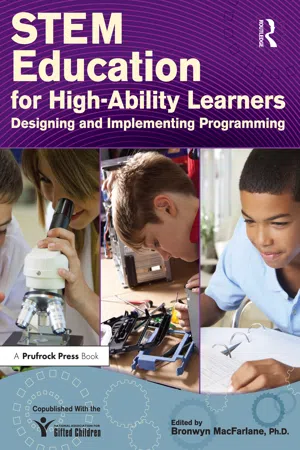
STEM Education for High-Ability Learners
Designing and Implementing Programming
- 290 pages
- English
- ePUB (mobile friendly)
- Available on iOS & Android
About this book
STEM Education for High-Ability Learners: Designing and Implementing Programming focuses on the rigorous articulation of quality STEM education programming to develop STEM talent among high-ability and gifted learners. The intent of this book is to provide a comprehensive resource for educators designing and implementing each of the supports within STEM education by providing a discussion of each critical component for inclusion in a planned, coherent, and high-quality sequenced system. This edited volume provides a cutting-edge discussion of best practices for delivering STEM education by experts in the field. The contributing authors provide a differentiated discussion and recommendations for the learning experiences of gifted students in STEM education programs.
Frequently asked questions
- Essential is ideal for learners and professionals who enjoy exploring a wide range of subjects. Access the Essential Library with 800,000+ trusted titles and best-sellers across business, personal growth, and the humanities. Includes unlimited reading time and Standard Read Aloud voice.
- Complete: Perfect for advanced learners and researchers needing full, unrestricted access. Unlock 1.4M+ books across hundreds of subjects, including academic and specialized titles. The Complete Plan also includes advanced features like Premium Read Aloud and Research Assistant.
Please note we cannot support devices running on iOS 13 and Android 7 or earlier. Learn more about using the app.
Information
PART I
Foundational Theories, Research, and Best Practices in STEM Education
CHAPTER 1
State Residential STEM Schools
A Case Study
Information About State Residential STEM Schools
Clarion Call For STEM Education
Brief History of State Residential STEM Schools
| School | Opening Year | Location | Website |
|---|---|---|---|
| Alabama School of Mathematics and Science | 1991 | Mobile, AL | www.asms.net |
| Arkansas School for Mathematics, Sciences, and the Arts | 1993 | Hot Springs, AR | www.asmsa.org |
| Craft Academy for Excellence in Science and Mathematics | 2015 | Morehead State University, Morehead, KY | www.moreheadstate.edu |
| Gatton Academy of Mathematics and Science in Kentucky | 2007 | Western Kentucky University, Bowling Green, KY | www.wku.edu |
| Georgia Academy of Aviation, Mathematics, Engineering, and Science | 1997 | Middle Georgia State College, Cochran, GA | www.mga.edu |
| Illinois Mathematics and Science Academy | 1986 | Aurora, IL | www.imsa.edu |
| Indiana Academy for Science, Mathematics, and Humanities | 1990 | Ball State University, Muncie, IN | www.bsu.edu |
| Kansas Academy of Mathematics and Science | 2009 | Fort Hays State University, Hays, KS | www.fhsu.edu |
| Louisiana School for Math, Science, and the Arts | 1983 | Northwestern State University, Natchitoches, LA | www.lsmsa.edu |
| Maine School of Science and Mathematics | 1995 | Limestone, ME | www.mssm.org |
| Mississippi School for Mathematics and Science | 1987 | Mississippi University for Women, Columbus, MS | www.themsms.org |
| Missouri Academy of Science, Mathematics, and Computing | 2000 | Northwest Missouri State University, Maryville, MO | www.nwmissouri.edu |
| North Carolina School of Science and Mathematics | 1980 | Durham, NC | www.ncssm.edu |
| Oklahoma School of Science and Mathematics | 1990 | Oklahoma City, OK | www.ossm.edu |
| South Carolina Governor’s School for Science and Mathematics | 1988 | Hartsville, SC | www.scgssm.org |
| Texas Academy of Mathematics and Science | 1988 | University of North Texas, Denton, TX | tams.unt.edu |
Types of State STEM Schools
Research on State Residential STEM Schools
A Case Study: The Gatton Academy of Mathematics and Science in Kentucky
Getting Started
Sending Schools
The Application Process
Student Benefits
Table of contents
- Cover
- Half Title
- Title Page
- Copyright Page
- Table of Contents
- Dedication
- Introduction
- Part I Foundational Theories, Research, and Best Practices in STEM Education
- Part II Applications to School-Based Practice With Gifted Education
- Conclusion
- About the Editor
- About the Authors